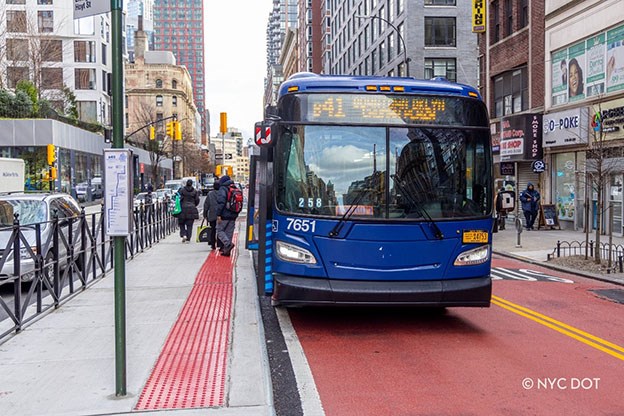Sweltering bus stops are a critical, overlooked and increasingly pressing risk factor to heat-related deaths, a recent report found.
Transportation Alternatives (TA), alongside the NASA DEVELOP Environmental Justice team, analyzed summer daytime temperature data at New York City bus stops using thermal heat imaging satellites. In their new report, Waiting for the Bus in New York City is Hot and Miserable. Here’s Why, data analysis sheds new light on where New Yorkers are waiting for the bus in dangerous, and even deadly, temperatures, according to a press release.
Nowhere in America is the “urban heat island effect” – when limited green space and widespread asphalt traps heat – worse than in New York City, where heat kills over 350 New Yorkers every year, the report said.
As summers grow hotter, bus stops are an under-recognized source of dangerous heat exposure in the five boroughs. With the slowest buses in the nation and wait times often stretching over 30 minutes, sweltering bus stops are a critical, overlooked, and increasingly pressing risk factor, according to the report.
The report found the hottest bus stops are 14.5°F hotter than the coolest – and more likely to be located in Black, Latino, Asian and high-poverty communities.
“Amid this summer’s never-ending heat waves, New York City is forcing millions of its residents to wait for a slow bus in the sweltering heat,” said Elizabeth Adams, interim co-executive director of Transportation Alternatives. “This report sheds new light on our city’s staggering misallocation of resources and lack of preparedness for the climate crisis – adding insult to injury and upholding a deadly status quo around transportation. The data shows, time and time again, that wealthier and whiter communities are waiting at cooler, safer bus stops. This is a policy choice that is entirely solvable, and we hope to see our city’s leaders make real, tangible changes to protect New Yorkers from excessive heat.”
With this data, TA identified 100 bus stops and three bus routes in need of urgent intervention. The 100 high-priority stops were identified by five characteristics: excessive heat, poor bus service, few alternate transit options, no bus shelters, and predominantly serving New Yorkers who depend on the bus or are low-income, Black or senior citizens. About 93% of New Yorkers living near these high-priority stops are people of color, and they’re also 29% more likely to be disabled and 45% more likely than the average New Yorker to depend on the bus to get to work, the report said.
TA released a list of recommendations for the New York City Department of Transportation and the Metropolitan Transportation Authority to improve sweltering bus stops. These recommendations include calls to install bus shelters with seating and countdown clocks at all high-priority bus stops and maintain rush-hour bus service all day on priority routes on days of extreme heat. Where sidewalks are narrow, they should reclaim parking spaces to create a bus bulb-out with room for a bus shelter.




